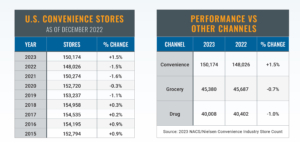Rising Opportunities in C-Stores and Gas Stations
July 31, 2023 – Atlanta, GA | In the dynamic landscape of commercial real estate, the convenience store market stands out as a sector that is both susceptible to threats and brimming with opportunities. Working exclusively in the convenience store asset class, SIG Investment Advisor Matthew Riznyk has a good pulse and keeps a close eye on industry trends and data. With changing consumer preferences and advancements in technology, convenience store operators and investors alike must navigate a rapidly evolving market to stay competitive and capitalize on emerging trends.
Throughout the pandemic, the demand for convenience products and fuel has remained high as the sector was considered an essential business. The need for quick refueling (both vehicles and individuals) is only increasing as more people return to their pre-pandemic routines, office schedules and travel. Operators that embrace foodservice, tech and serving electric vehicle owners are achieving higher returns than ever.
The sales and popularity of electric vehicles (EVs) are on the rise, driven by factors such as increasing consumer demand and the availability of Federal tax credits for EV purchases. While this is seen as a challenge by many, it is seen as an opportunity by the retail community. Adding charging stations has become a revenue driver for many urban and highway locations, and operators are in a strong position to capitalize on the increased time it takes to charge vs fuel traditionally, focusing on expanding and enhancing their in-store experience and foodservice options. This requires a shift in mindset and investment in areas such as menu innovation, quality improvement, and customer experience to attract and retain customers who may visit convenience stores less frequently for fuel but are drawn in by appealing food options and outstanding amenities.
 In addition to EV-related challenges, convenience store owners are facing higher operating expenses due to factors such as high inflation rates. This results in increased costs for labor, card fees, repairs, and maintenance. Operators now need to adopt a strategic and proactive approach to cost management. Regional and national chains are performing better due to having economies of scale and efficiency. Overall, convenience stores in the U.S. are making a strong comeback after the pandemic and growing comparatively faster than the grocery and drugstore segment. Chain stores are surging; creating operational benefits from economies of scale to tackle inflation and rising costs while also creating investment opportunities from corporate and franchise tenants.
In addition to EV-related challenges, convenience store owners are facing higher operating expenses due to factors such as high inflation rates. This results in increased costs for labor, card fees, repairs, and maintenance. Operators now need to adopt a strategic and proactive approach to cost management. Regional and national chains are performing better due to having economies of scale and efficiency. Overall, convenience stores in the U.S. are making a strong comeback after the pandemic and growing comparatively faster than the grocery and drugstore segment. Chain stores are surging; creating operational benefits from economies of scale to tackle inflation and rising costs while also creating investment opportunities from corporate and franchise tenants.
The bottom line is that the Convenience store industry is healthy and not going anywhere. With strong business fundamentals and revenue potential, well qualified and disciplined operators are generating strong returns. To further their growth strategies, many of these same operators are utilizing sale leasebacks to capitalize themselves, avoid excessive leverage, and allow them to focus on the retail experience and fine-tuning their operations. This trend also increases the amount of opportunity and available inventory for c-store investors to buy the real estate component of an expanding asset class. The benefits to an investor go beyond a growing and profitable industry but also deliver historically higher cap rates and yield than traditionally seen in the market, all coupled with superior depreciation benefits.
 “The numbers speak for themselves; we have seen Gas Station and Convenience store purchases accelerating in recent years as more savvy investors take advantage of the high yields, stability and unique tax benefits of this first-rate asset class.” – Matthew Riznyk
“The numbers speak for themselves; we have seen Gas Station and Convenience store purchases accelerating in recent years as more savvy investors take advantage of the high yields, stability and unique tax benefits of this first-rate asset class.” – Matthew Riznyk
Check out our Newest Gas Station and Convenience Store Opportunities.
This article was originally featured in WMRE Midyear Outlook 2023.
Download SIG’s C-Store Market Report
By submitting your information and signing up for email updates, you agree to SIG Online Terms of Use

